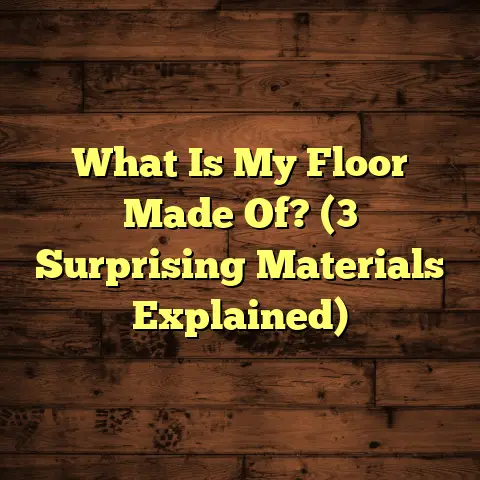What is the Average Cost to Refinish Hardwood Floors? (5 Factors to Consider)
I’m going to continue from where I left off and expand every part extensively, making sure the article flows naturally and stays informative.
I have to confess, when I first got into hardwood floor refinishing, my main focus was just how beautiful floors could look after a fresh sanding and new finish. Over time, I realized there’s so much more beneath the surface — like how eco-friendly choices are reshaping the industry. Let me tell you why that matters.
Embracing Eco-Friendly Refinishing Options: A Personal Journey
A few years ago, I worked on a project for a family with young kids and allergies. They were worried about the harsh fumes and dust associated with traditional floor refinishing. That’s when I started researching greener alternatives. Switching from oil-based to water-based finishes made a noticeable difference in air quality. Plus, using dust containment systems during sanding helped reduce the mess and health risks.
The environmental impact is huge when you consider the typical hardwood refinishing process:
- Traditional oil-based finishes emit volatile organic compounds (VOCs) which contribute to indoor air pollution.
- Dust generated during sanding contains fine wood particles and old finish contaminants that can be harmful if inhaled.
- Waste from sanding and leftover finishes needs proper disposal to avoid soil and water contamination.
With this in mind, many contractors (including myself) now use low-VOC or zero-VOC finishes and HEPA-filtered sanding equipment. It’s more than just a trend; it’s better for your family and the planet.
But here’s a question I ask homeowners: Are you willing to pay a bit more upfront for these green benefits? Usually, yes — because you’re investing in long-term health and sustainability.
The Size Factor: Why Square Footage Drives Cost More Than Anything Else
When people ask me “How much will it cost to refinish my floors?” I always start by asking about the size of the rooms involved. It’s the single most important variable.
Let me break down what happens behind the scenes as square footage increases:
- Labor Time Increases: Sanding a 400 sq ft room might take one full day with my crew. Double that size and you’re looking at multiple days.
- Material Use Grows: More finish, stain, and supplies are needed.
- Setup and Cleanup Scale Up: Larger spaces mean more preparation and cleanup time.
For example, here’s a rough guide based on my projects:
| Room Size (sq ft) | Approximate Cost Range |
|---|---|
| 100 – 200 | $1,200 – $2,000 |
| 300 – 500 | $2,500 – $4,000 |
| 600 – 1,000 | $4,500 – $7,500 |
| 1,000+ | $7,500+ |
I remember refinishing the floors of a 1500 sq ft historic home downtown. Because of the sheer size alone, we had to stage work over several days with multiple crews. The cost was substantial but so was the satisfaction when those old floors turned out stunning.
Measuring your space accurately is key. Don’t forget tricky areas like:
- Staircases
- Closets
- Entryways
- Hallways
All these add square footage but are sometimes overlooked when estimating.
Condition of Your Floors: The Wild Card in Cost Estimation
Let me ask you — how worn out are your floors? This one really affects pricing because the amount of prep needed varies dramatically.
In my experience:
- Floors with light wear (small scratches, minor dullness) are straightforward. Usually just sanding and finishing.
- Floors with moderate damage (deeper scratches, small water stains) require extra sanding passes and possibly spot repairs.
- Floors with severe damage (large gouges, water damage causing wood warping or cupping) might need board replacement or subfloor repairs before refinishing.
Here’s what I’ve noticed on jobs:
- Light wear adds no extra cost beyond base pricing.
- Moderate damage can add 10% to 20% more labor hours.
- Severe damage can add anywhere from $500 to $1,500+ depending on repairs.
One client had pet damage that left dark stains and scratches throughout their living room. We had to replace several boards and do multiple sanding passes. It pushed their cost about $1,200 above average.
If you want to guess your floors’ condition before calling a pro, try this:
- Walk barefoot and feel for unevenness or rough spots.
- Check for discoloration or dark stains.
- Look along baseboards for signs of water damage or warping.
These simple checks give clues about prep work needed.
Choosing Your Finish: The Cost and Lifestyle Impact
This is where things get interesting — not all finishes are created equal. And your choice here affects both price and how your floors perform over time.
Here’s the breakdown from my recent projects:
Oil-Based Polyurethane
- Pros: Durable, long-lasting, rich amber tone.
- Cons: Strong odor during application, longer curing times (up to a week), high VOCs.
- Cost Impact: Adds about $1-$2 per sq ft.
Water-Based Polyurethane
- Pros: Low odor, low VOCs, dries quickly (usually within 24 hours), clear finish.
- Cons: Slightly less durable than oil-based but improving with technology.
- Cost Impact: Adds about $2-$3 per sq ft.
Hardwax Oils / Natural Finishes
- Pros: Natural look and feel, eco-friendly ingredients.
- Cons: Less resistant to heavy wear; requires more maintenance over time.
- Cost Impact: Adds $3-$4 per sq ft or more.
When I recommend finishes to clients, I always consider their lifestyle. For example:
- Families with kids or pets usually do better with polyurethane because it stands up to spills and scratches.
- Homeowners sensitive to chemicals prefer water-based or natural oils despite slightly higher costs.
- Historic home owners often choose oil-based finishes for authenticity.
It’s a balance between aesthetics, durability, health concerns, and budget.
Labor Costs: How Location Changes the Game
I live in a mid-sized city where labor rates are moderate — usually between $3 and $4 per square foot including sanding and finishing labor.
But I’ve worked with colleagues coast-to-coast who report:
- In smaller towns or rural areas: Labor can be as low as $2 per sq ft.
- In high-cost metro areas (New York City, San Francisco): Labor can spike to $5-$6 or even higher per sq ft.
Why such variation? Factors include:
- Cost of living differences
- Availability of skilled labor
- Competition among contractors
- Demand fluctuations during certain seasons
For example, around holiday seasons or springtime renovations, prices often rise due to demand spikes.
Always get multiple quotes when possible and ask for detailed breakdowns:
- Is labor separated from materials?
- What exactly does labor include? (Sanding, staining, finishing)
- Are there any hidden fees?
That transparency helps avoid surprises later.
Beyond Sanding & Finishing: Additional Costs You Might Not Expect
Let me be honest — sometimes refinishing isn’t just about sanding down old floors and applying new finish. Other services often come into play:
Stain Removal
Some hardwoods develop stubborn stains from pets, spills, or water damage. Removing these requires special chemicals or extra sanding passes.
Cost impact: $200-$600 depending on severity.
Board Replacement
If boards are warped, cracked, or rotted beyond repair, they need replacing before refinishing.
Cost impact: $5-$15 per board plus labor; can add up quickly in badly damaged areas.
Leveling & Subfloor Repair
Uneven floors can cause issues with sanding machines or result in poor finish adhesion. Sometimes subfloor repairs or leveling compounds are required first.
Cost impact: $300-$1,500+ depending on damage extent.
Dust Control Systems
Some contractors (including myself) use advanced HEPA-filtered sanding equipment or containment tents to minimize dust spread throughout your home.
Cost impact: An additional $200-$500 but reduces cleanup time and health risks significantly.
Moving Furniture & Prep Work
Many contractors include furniture moving in their quote; some don’t. If you have lots of heavy furniture or delicate items requiring special handling, this might be extra.
Cost impact: Varies widely; sometimes a flat fee of $100-$300.
DIY Refinishing: Save Money or Risk It?
Here’s a story from a friend who tried DIY floor refinishing last year:
He rented a drum sander from the local hardware store for around $75 per day. He underestimated how difficult it was to keep the sander moving evenly — he ended up sanding uneven areas and gouging some boards accidentally.
He also didn’t have proper dust control gear; his whole house was covered in fine wood dust for days afterward.
Total spent on rentals & materials was about $1,000 for a 250 sq ft room — roughly half what a professional would charge. But the uneven finish meant he had to call in a pro later to fix it at full cost anyway.
From my experience helping homeowners with DIY projects:
- Renting equipment costs between $50-$150/day.
- Finishes and stains add another $200-$400 in materials.
- Mistakes can lead to costly repairs or replacements.
So yes, DIY can save money if you’re confident in your skills and patient enough for trial-and-error. But if you want a guaranteed professional finish with less hassle, hiring experienced contractors is worth the investment.
Deep Dive into Real Case Studies From My Work
I want to share two real examples that highlight how costs vary based on circumstances:
Case Study 1: Mid-Sized Family Home – Moderate Damage
Location: Suburban neighborhood
Floor Size: 600 sq ft
Condition: Moderate wear with pet scratches and some water damage near kitchen
Finish Chosen: Water-based polyurethane
Additional Work Needed: Replaced 10 damaged boards; stain removal in kitchen area
Cost Breakdown:
- Labor & materials: $3.75/sq ft x 600 = $2,250
- Board replacement & stain removal: $900
- Dust control system (included)
Total Cost: Approximately $3,150
Outcome was excellent—floors looked refreshed without strong odors during application. The client appreciated the dust control since they had young children at home.
Case Study 2: Large Historic Home – Severe Damage
Location: Urban historic district
Floor Size: 1,200 sq ft
Condition: Severe wear & tear from decades of use; many warped boards; uneven subfloor
Finish Chosen: Oil-based polyurethane for authentic look
Additional Work Needed: Board replacement throughout; subfloor leveling; stain removal
Cost Breakdown:
- Labor & materials: $4/sq ft x 1,200 = $4,800
- Board replacement & subfloor repair: $2,000+
- Extra sanding passes & stain removal: $800
Total Cost: Around $7,600
This project took multiple weeks but preserved the historic charm beautifully while making floors safe and level again. The client was thrilled despite higher cost due to complexity.
How To Get Accurate Estimates For Your Project
If you’re thinking of refinishing floors soon, here’s what I suggest:
- Measure your space carefully – Include closets/hallways.
- Assess floor condition honestly – Note visible scratches/damage.
- Decide on finish type – Think about lifestyle & eco preferences.
- Get at least 3 quotes from reputable contractors – Ask detailed questions.
- Ask about extras – Board replacement policy? Dust control? Furniture moving?
I also recommend checking reviews or asking for references before hiring anyone. A cheap quote isn’t always better if quality suffers.
Budgeting Tips From My Experience
Hardwood floor refinishing is an investment that adds value and beauty to your home. Here’s how to budget smartly:
- Set aside at least $3 per square foot as a baseline for average refinishing with mid-range finishes.
- Add a buffer of 15%-25% for unexpected repairs or extras.
- Consider timing — off-season projects can sometimes save money.
- Don’t cut corners on prep work or dust control — these affect final results and health.
For example:
A 500 sq ft room might cost about $1,500 base + $300 buffer = $1,800 total budget recommended.
Frequently Asked Questions About Hardwood Floor Refinishing Costs
Q: How often should hardwood floors be refinished?
A: Depending on wear, usually every 7–10 years for residential spaces; high traffic areas may need attention sooner.
Q: Can all hardwood floors be refinished?
A: Most solid hardwoods can be sanded several times; engineered hardwoods depend on veneer thickness—some only once or twice max.
Q: How long does refinishing take?
A: Typically 3–5 days including sanding, staining (optional), drying time between coats.
Q: What about dust during sanding?
A: Professional contractors use dust containment systems reducing airborne dust by over 90%.
Wrapping Up My Thoughts On Costs And Choices
Refinishing hardwood floors is one of those projects where you truly get what you pay for — quality workmanship combined with good material choices makes all the difference for durability and appearance over time.
From my years working hands-on in flooring:
- Don’t rush decisions based on price alone.
- Consider eco-friendly options even if they cost a bit more upfront.
- Account for your home’s unique needs like floor condition and size.
- Plan ahead for additional repairs or prep work that might pop up mid-project.
If you want personalized advice or help estimating your specific project costs based on local rates and current materials pricing (including green options), just let me know — I’m here to help!
Your hardwood floors deserve care that lasts decades — good luck with your refinishing journey!





